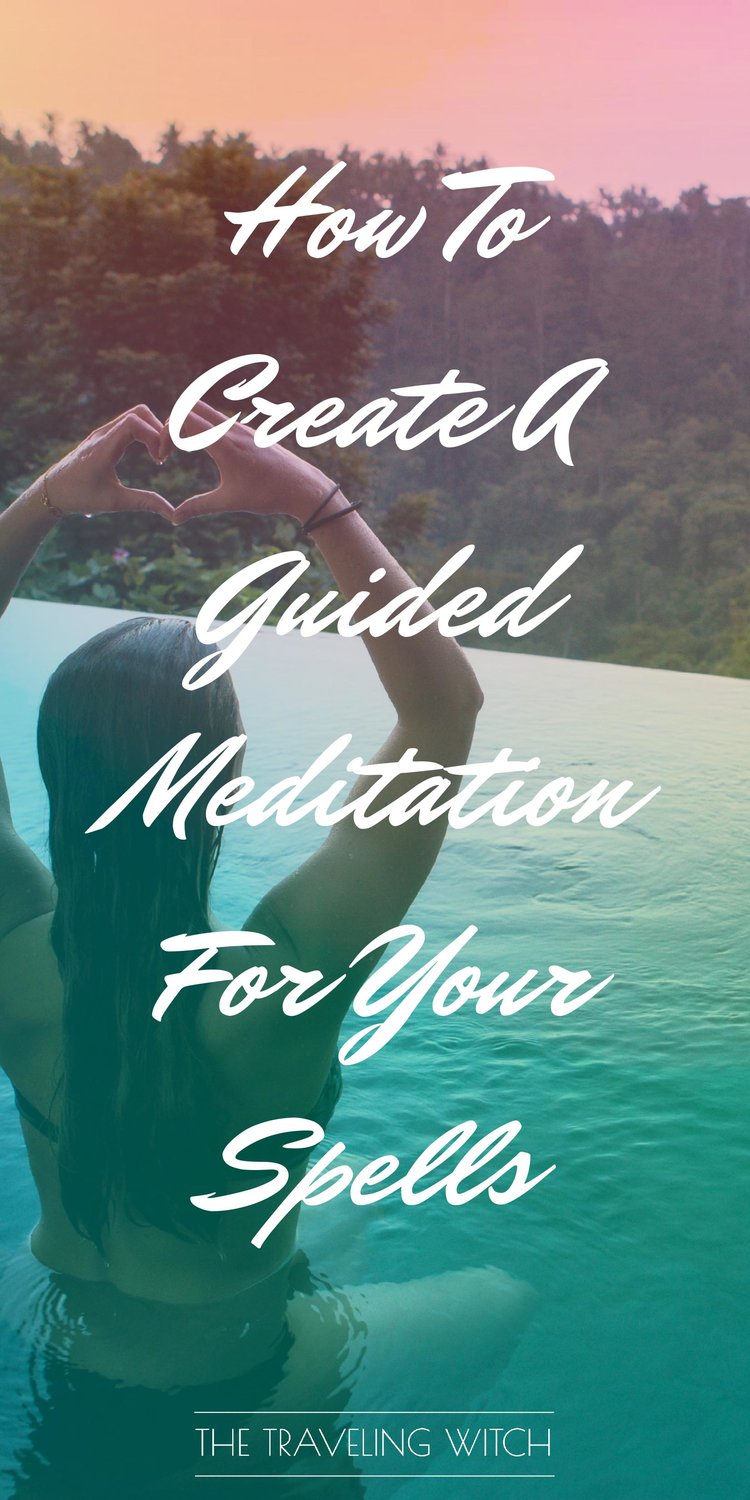Many witches are familiar with using crystals, oils, herbs and candles in their spells and rituals—but one of the most effective tools in magic comes from within. Your mind is powerful, and the more you can explore how it can affect your magic, the more you can use it to strengthen and add focus your spells. Meditation is a great way to harness the power of your mind while performing spells.

There are many different forms of meditation, but my all-time favorite for magical use are Visualization Meditations. Whenever you perform a spell with specific results in mind, consider using a guided visualization meditation to continue your magic throughout the following week, month or even year. Visualization meditations will reinforce your magical intention by walking you through every detail of your spell’s ideal outcome. This keeps you focused on the results and encourages you to believe that your desire is on its way to you.
How To Create A Visualization Meditation
Step One: Get Specific with your Desired Outcome
The first thing you need to do when creating a witchy meditation is to decide exactly what you want your spell to accomplish. Spend some time journaling about what your life will look like once your spell has manifested. Ten to twenty minutes is plenty, but write until you feel complete.
For example: if you perform a spell to bring you a work-from-home job, take a few minutes to break that intention down into tiny pieces. You can do this by writing a description of a typical day in your life once this desire has manifested. How will a work-from-home job change your life? What things will it allow you to do? How will it make you feel? What will your schedule look like from the moment you wake up to the moment you go to bed? Get as detailed as you want with this exercise and include lots of emotion in it. Write in first person and present tense to make your words feel more personal and immediate. Most importantly, remember to have fun with this! If this starts to feel like a chore, take a break and come back to it later.
My journaling around this intention could go something like this:
“I love my new job working from home. I wake up in the morning and take my time making coffee and leisurely cooking a nice breakfast for myself and my family. After I finish eating, I begin my workday routine which includes reading and answering emails, doing a conference call, and working on that day’s projects.
Today, I’m working on something I’m really excited about—a logo design for a new clothing company. I get started by sketching out different concepts on my notepad while I sit on my patio and enjoy the warm sun on my arms. I can smell floral scents wafting up from my neighbor’s garden and it gives me a sense of contentment. I’m wearing my comfiest pants and tank top—an outfit I’d never be able to get away with at my old job. This thought makes me smile. I get to wear comfy pants on a Monday morning—I’m the luckiest woman in the world!
Around noon, I take a break for lunch and I meet a friend at my favorite cafe for sandwiches and good conversation. She asks me how I like my new job, and I gush about how it’s made my life so much more balanced and fun. After lunch, my friend leaves and I stay at the cafe to get some more work done before I close my laptop for the day and head home…”
Go moment by moment until you’ve documented what an entire day would look like after your spell has worked its magic.
Step Two: Read it Out Loud And Make Edits
Read your journal entry out loud. Add any details you’ve left out, and take out anything that doesn’t make you feel excited. Look for more ways you can get all your senses involved. What smells, sights, sounds, tastes and physical sensations appear in your ideal day? Try to include at least one detail that focuses on each of your five senses in your journal entry. This will help your meditation feel more “real” to you.
Step Three: Time Yourself Reading Your Journal Entry
Time yourself reading your edited entry out loud, slowly and clearly. Pause briefly after every sentence. Those pause will give your mind time to create more vivid images during your meditation. Slower is better.
Your journal entry is basically the word-for-word script for your witchy meditation. If you read through the whole thing in less than a minute (including a slow pace and pauses), add more details to your journal entry. I like to make my meditations between five and ten minutes long. Any shorter than five minutes and I feel like I don’t have time to fully immerse myself in my vision. Any longer than ten minutes and I’m tempted to skip my meditation entirely when I’m running late or feeling too tired.
Step Four: Record Your Meditation
There are so many ways to record yourself, so pick the technology you’re most comfortable using. You can use a good old tape recorder with a built in microphone, or you can hook up your fancy podcast mic to your laptop and record with a program like Adobe Audition or Garageband. There are pros and cons to every recording method, so I encourage you to experiment with whichever one works best for your needs.
I like to use the free “voice memo” app on my iPhone to record my visualization meditations. I’ll go to a quiet area where I know I won’t be disturbed and hit the record button on my phone. It’s a simple no-frills approach that has never let me down. I’ll save the recording on my phone and give it a title I’ll easily recognize. Using the earlier example, I’d call this meditation, “My Work-From-Home Meditation”.
If you love music, you can pick a song to play at the beginning and/or end of your meditation. I prefer mellow instrumental music for my recorded meditations, especially the classical and cinematic-style playlists on Spotify. (Note: If you choose to add music to your meditation, you won’t be able to distribute it to others for copyright reasons. If you do plan on sharing it with others, do a Google search for “Royalty-Free Music” and check out the results. There are hundreds of sites that specialize in affordable royalty-free music.)
The last thing to remember as you’re recording your meditation is to make sure you’re in a good mood when you do it. If you record your meditation from a place of tiredness or sadness, that energy might slip into your words—even if it’s only on a subconscious level.
If you’re going through a tough time, find a way to lift your mood even if it’s only for a few minutes. Go for a walk in nature, take a bubble bath or call up your bestie for a chat before you record your meditation. Maybe you need to watch an episode of your favorite TV show to lift your spirits. Whatever you need to do, do it! The more joy you can pour into your guided meditation as you read it, the more joy you’ll feel every time you listen to it.
Step Five: Test Out Your Meditation
Test out your guided meditation recording before you make it a part of your daily (or weekly or monthly) witchy practice. Sit or lay down in a comfortable position and close your eyes. Spend one to three minutes focusing on nothing but your breathing. If any thoughts float into your head as you’re beginning your meditation, just let them pass through without any attachment or judgement. When you feel pretty relaxed and are ready to dive into your meditation, play your recording either through speakers or headphones.
Listen once and allow yourself to be mentally “led” through your ideal day. See yourself working on your laptop in your apartment. Allow yourself to be transported into this “imaginary” world you’ve created for yourself in this recording. Let yourself feel all the excited, happy or peaceful feelings that you hope this spell will bring you.
When the recording is over, open your eyes and ask yourself these questions:
-Could I see myself clearly throughout this entire meditation?
-Do I believe this ideal outcome is possible for me?
-Did this meditation bring up strong positive feelings inside of me?
If the answer is yes to these questions, congratulations! You’ve made an effective meditation to support your spell. If the answer is no to any of those questions, go back to your journal entry “script” and tweak it until you can answer yes to all of those questions.
Step Six: Make a Plan for How Often You’ll Meditate
Decide on a time, place and frequency of your meditations. For my “Work-From-Home Meditation” example, I could choose to listen to my recording once while I’m performing my spell, and then twice a day for the seven days after my spell.
Maybe you’d like to try doing your meditation once a week for the four weeks following your spell. If you’re working towards a big goal, you might consider listening to this meditation once a month for an entire year.
As for the time of day to meditate, I think it’s helpful to combine this meditation with a habit you’ve already established in your life, such as brushing your teeth. You know you’re going to remember to brush your teeth twice a day, so why not listen to your meditation immediately after you brush your teeth? I’ve also experimented with doing a meditation right after I wake up in the morning, and again right before I fall asleep.
Regarding a place to meditate, I recommend picking a space that is both quiet and comfortable. This could be at your altar, on your bed, in your living room or in your car on your lunch break. Wherever you choose to meditate, try to stay consistent.
More Ways To Meditate
If you really enjoy creating and listening to your own guided visualization meditations, try exploring ways to meditate with other mediums. Do you draw or paint? Try creating a visual representation of your spell’s desired outcome. Do you dance? Choreograph a sequence that tells the story of your ideal day. Push the boundaries of your witchcraft and see how many ways you can integrate a meditation practice into your magic.
New to witchcraft?
Sign up for my FREE Witchcraft class!



